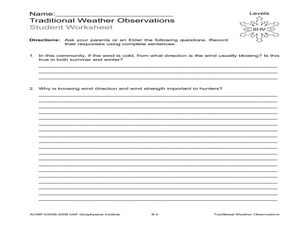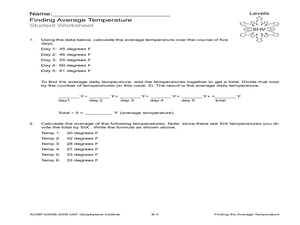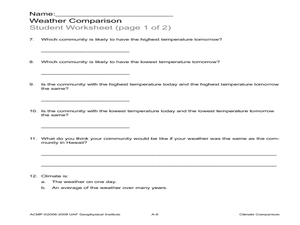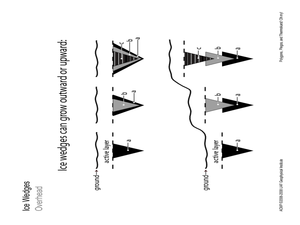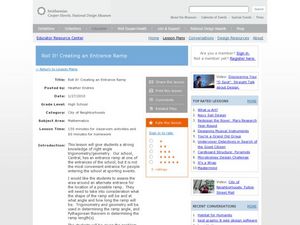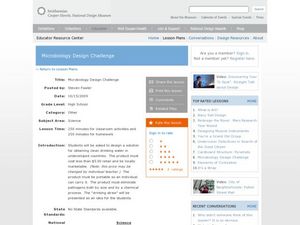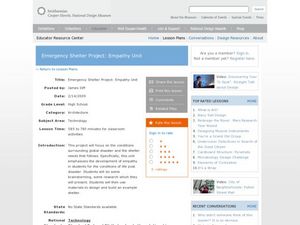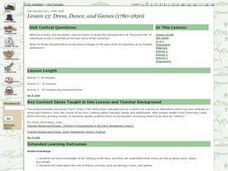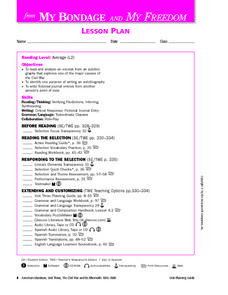Curated OER
Choosing the Best Graph
Eighth graders produce and examine two sets of data and create what they believe to be the most appropriate graphs to represent these sets of data. After completing the pre-assessment, they discuss reasons for using each type of graph...
Curated OER
Then, Now, and Tomorrow
Students will use this unit to investigate the past, present, and future of the architecture and plan of New York's Lower East Side. Students will research the history of the Lower East Side neighborhood in photographs used from the...
Curated OER
Habitat
Pupils are able to define habitat. They are able to identify the four things that living things need to survive. Students are able to describe how living things are adapted to their habitats.
Curated OER
A Tall Ship and a Star to Steer Her By
Students create a water transportation device powered by wind. In this wind power lesson, students research transportation concepts after reading the poem "Sea Fever" by John Masefield. Students design the fastest sailboat they can...
Curated OER
Changing the World: Social Entrepreneurs Part One
Learners analyze the purpose of a social entrepreneur. For this entrepreneurship lesson, students create a "help wanted" advertisement and graphic organizer to provide information on how a social entrepreneur seeks long-term change by...
Curated OER
Weather Observation Journal
Students research weather patterns. In this weather lesson, students read Chester Noongwook's Rules of Weather Observation and keep a weather journal for one month. Students observe the weather patterns throughout the month.
Curated OER
Traditional Weather Observations
Students explore traditional methods of weather observation. In this weather lesson, students interview grown-ups regarding wind. Students learn how winds can help forecast weather.
Curated OER
Solid Water
Students turn solid water (ice) into liquid water. In this solid and liquid water lesson plan, students use water, ice, cups, and heat in order to change water from one state to another. They draw their findings as well.
Curated OER
Seasons
Students name the 4 seasons, discussing the weather, plant life, animal life and and activities of each. Students read the book titled, "Hello Arctic," and and discuss changes in seasons that accompany the story. Students complete...
Curated OER
Subsistence Calendar
Learners create a subsistence calendar for seasonal activities in their community. In this seasonal activities lesson plan, students research the four seasons in their community and write down the activities to do in that season.
Curated OER
Finding the Average Temperature
Students calculate averages. In this average temperature activity, students collect data and use their problem solving skills to calculate average temperatures.
Curated OER
Go Glacier Go!
Students create a model of a glacier and observe how it moves. In this landforms lesson, students learn what a glacier is, build a model glacier and observe how it moves in a manner that more closely resembles a liquid than a solid.
Curated OER
Climate Comparison
Young scholars explore climate regions. In this climate lesson, students examine the climate regions of Alaska as well as the state of Hawaii. Young scholars research selected Internet sources to gather information regarding the climates...
Curated OER
Polygons, Pingos, and Themokarst! Oh MY!
Learners complete activities to learn about the common land features in Alaska. In this land study lesson, students study an overhead for permafrost features. Learners define ice wedge polygons, thermokarst, and pingos. Students also...
Curated OER
Walking on Frozen Ground
Students listen to an Elder speak about permafrost structures in their area. For this permafrost lesson plan, students listen to the guest speaker, take a tour outside to view permafrost structures, and draw them.
Curated OER
Water, Water Everywhere
Students explore water. In this water cycle lesson, students conduct a scientific investigation that requires build a terrarium models of the earth. Students record their observations of the changes regarding water in the terrarium.
Curated OER
Roll It! Creating an Entrance Ramp
Students explore the concept of triangles. In this triangles lesson plan, students are to propose a plan for a ramp at their school. Students use the Pythagorean Theorem and trigonometry to determine the length, height, and...
Curated OER
Microbiology Design Challenge
Students discover dangers to human health by researching what's in our drinking water. In this water purification lesson, students discuss the conditions of water in undeveloped countries and why it is unsafe to drink....
Curated OER
Design a Better Classroom Workplace
Students design a new classroom workplace. In this architecture lesson, students use area formulas to identify the problem with the existing desks in their classroom. Students design their own solution volume formulas to solve the...
Curated OER
Emergency Shelter Project: Empathy Unit
Students design emergency shelters. In this designing emergency shelters lesson, students discuss living conditions of people after a natural disaster. Students discuss the tsunami that struck East Asia. Students design...
Curated OER
New england (1780-1820): Dress, Dance and Games
Students examine and discuss nineteenth century clothing and compare it to contemporary styles. After writing paragraphs describing the clothing styles, they play games from the period. For homework, they create their own games to play...
Curated OER
Fossil Fuels vs. Alternative Fueling Systems
Fourth graders brainstorm the differences between the fossil fuels that people use in their transportation now and what they could use to minimize greenhouse gas emissions. They use a variety of techniques from webquests to writing...
Curated OER
American Literature and the Civil War
Students prepare for and respond to literature selections. This package includes fourteen lessons from the American Literature, The Civil War and Its Aftermath: 1845-1880 series, each covering a different reading selection. Pre-reading...
Curated OER
Heart Mobiles In Action
Students design a mobile or wall hanging that reviews the circulatory system. In this circulatory system lesson, students work in small groups to identify the structures of the heart, and create a model in the form of a two or three...








